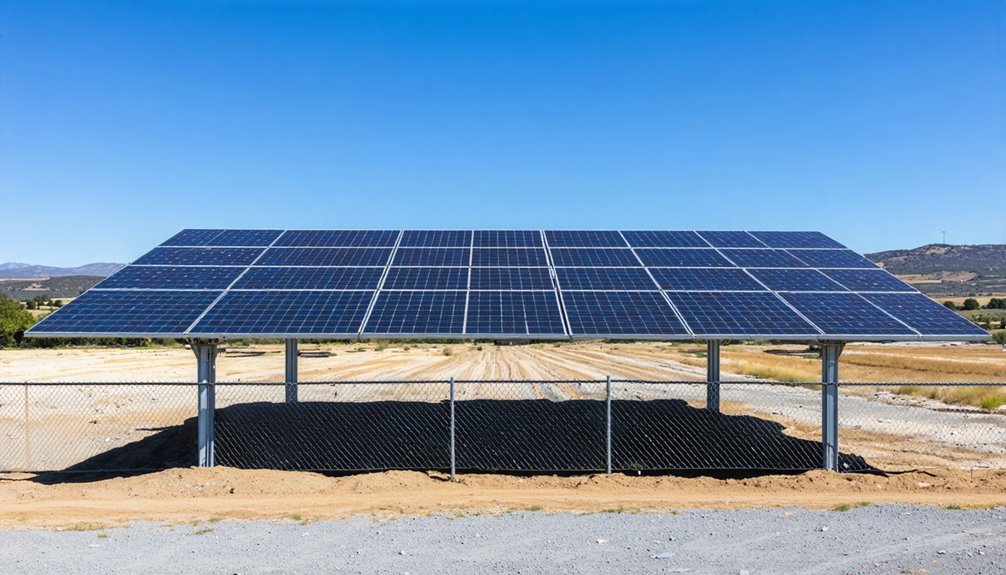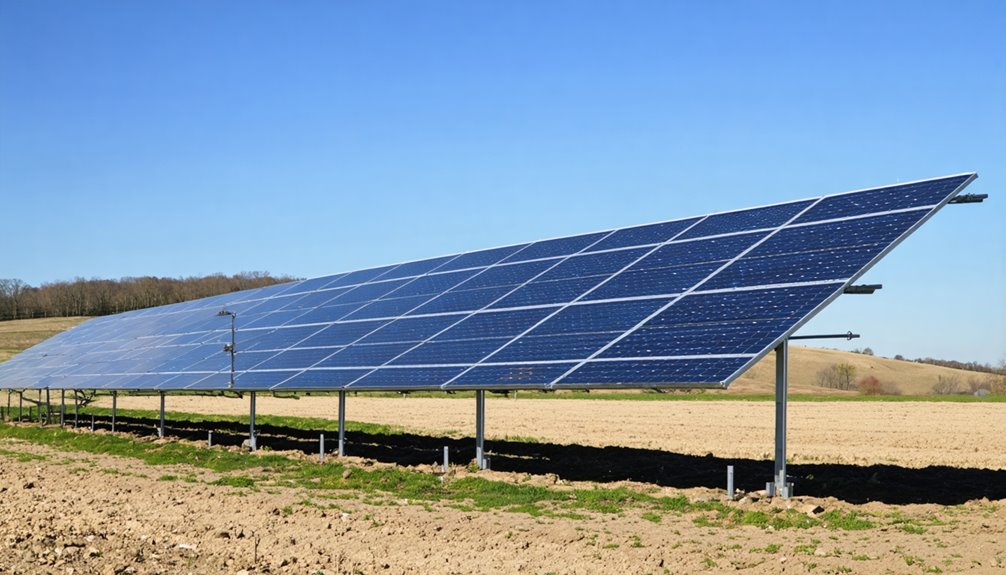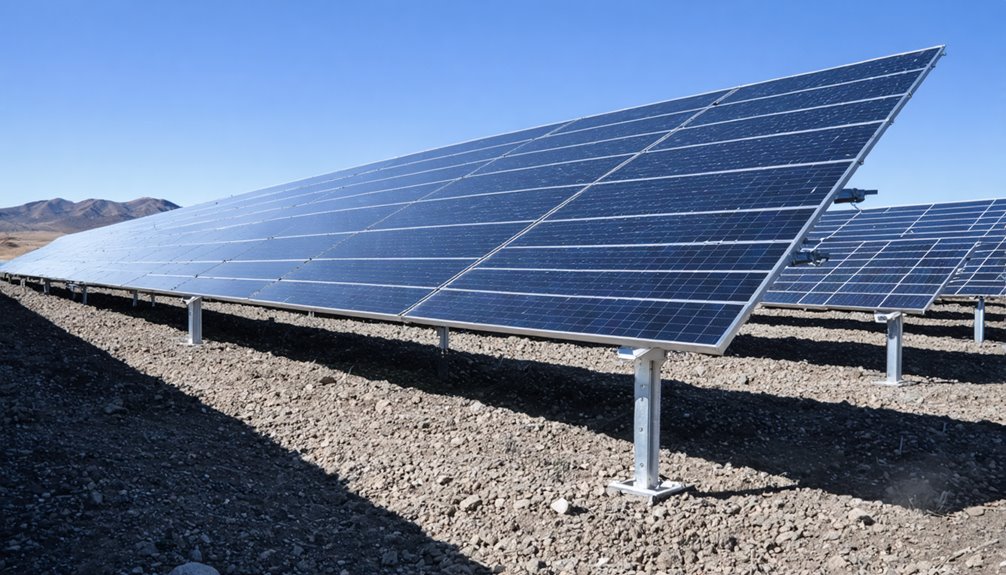Ground-mounted solar panels typically stand 3 to 5 feet above the ground, varying with environmental conditions and installation needs. Panels can be oriented in portrait or landscape configurations, measuring around 205 cm and 244 cm high, respectively. Ideal height enhances sunlight exposure, efficiency, and energy production, while accommodating safety and terrain considerations. Factors like tilt angle, airflow, and local climate also influence height for solar performance maximization. Explore further to understand how ideal panel height impacts efficiency.
Average Height of Ground-Mounted Solar Panels
When determining the average height of ground-mounted solar panels, it’s essential to take into account various contributing factors that guarantee ideal sunlight exposure and system efficiency. Beyond the basics of installation, ground-mounted systems benefit from siting flexibility that allows optimizing tilt and orientation for higher energy production. Typically, the panels stand 3 to 5 feet above the ground, but this range isn’t fixed. Factors like environmental conditions and specific installation height requirements can vary based on terrain. For flat terrains, installations are often 3 to 4 feet high to achieve peak efficiency. However, sloped terrain or regions with heavy snowfall may require higher setups to facilitate proper angle adjustments and prevent shading. Urban installations tend to have lower configurations to blend with the surrounding environment, whereas rural setups may opt for higher configurations, enhancing solar exposure and yielding maximum energy efficiency.
Types of Ground-Mounted Solar Panels and Their Dimensions
Ground-mounted solar panels come in two primary configurations: portrait and landscape, each with distinct dimensions that cater to various installation needs. The portrait configuration typically stands at 205 cm in height, while landscape panels measure 244 cm. Both types have a standard weight of around 3,800 grams. To achieve optimized solar exposure, panels often adopt a tilt angle between 10 to 30 degrees, enhancing airflow and maintenance convenience. A typical setup involves installing panels 3 to 5 feet above ground level, ensuring effective height management. Here’s a table overviewing the key dimensions:
| Configuration | Height | Standard Weight |
|---|---|---|
| Portrait | 205 cm | 3,800 grams |
| Landscape | 244 cm | 3,800 grams |
Ground-mounted systems, structured in four rows, accommodate various length requirements based on setup size.
A key planning step involves accurate site assessment to determine sun exposure and shading.
Key Factors Influencing Panel Height
After exploring the various types and dimensions of ground-mounted solar panels, it’s important to understand the key factors influencing their installed height. Typically ranging from 3 to 5 feet, the height of these panels can appreciably differ based on various conditions. On a sloped terrain, you might need to increase the height to guarantee the solar panels receive the ideal sun angle and exposure while flat terrains usually stick to lower heights, around 3 to 4 feet. Local climate conditions, such as snow accumulation, play a vital role in adjusting heights, preventing damage and maintaining efficiency. In urban areas, installations often adhere to lower heights to blend with the environment, whereas rural regions might support taller configurations for improved solar capture. A well-designed ground mount systems approach can enhance stability and maintenance access.
Regional Standards and Considerations for Installation

Although regional standards greatly impact the installation of ground-mounted solar panels, it is essential to acknowledge the diverse considerations that influence these decisions. Urban areas often impose lower height regulations, aligning with zoning restrictions and community aesthetics, ensuring seamless integration within the architectural landscape. In contrast, rural settings might support higher installations, optimizing solar exposure without the constraints of visual obstruction. Installation guidelines also consider local climate conditions, as higher panels can address snow accumulation and prevent damage from heavy rainfall. Safety compliance is a priority, with height regulations ensuring stable and secure installations. Effectively understanding and adhering to regional standards fosters energy efficiency, minimizes zoning conflicts, and aligns installations with both technical specifications and aesthetic expectations of the community.
Effects of Terrain on Solar Panel Height
When considering the installation of ground-mounted solar panels, terrain plays a significant role in determining the height requirements necessary for ideal solar exposure and energy efficiency. On flat terrains, a height of 3 to 4 feet typically suffices for optimal exposure. However, sloped terrains might necessitate increased heights to maintain the appropriate tilt angle, essential for effective energy capture. Fixed-tilt systems generally require different height specifications compared to adjustable systems, which may vary based on the seasonal sun movement. Additionally, in regions experiencing significant snowfall, solar panels may require increased heights to prevent snow accumulation. Local climate factors, like heavy rainfall, also influence installation height, as higher setups can help avoid potential flood damage, safeguarding consistent energy production. Additionally, cost-related factors such as local labor rates and permitting requirements can shape practical height choices, especially on complex or remote sites.
Importance of Choosing the Correct Panel Height
You need to select the correct panel height for ground-mounted solar systems to optimize sunlight exposure, which is essential for maximizing energy efficiency. Proper height guarantees easy access for maintenance and cleaning, enhancing long-term performance and system reliability. By taking into account factors like shading, airflow, and environmental risks, you can effectively maintain high energy output and secure the durability of your solar installation. Pole-mounted configurations also offer enhanced durability and easier maintenance in remote locations, thanks to their ground-based design, improving adjustability for sun exposure across seasons.
Optimize Sunlight Exposure
To effectively enhance sunlight exposure for ground-mounted solar panels, selecting the correct panel height plays an indispensable role, impacting energy efficiency and system reliability. Typically, keeping the height between 3 to 5 feet maximizes sunlight exposure, promoting efficient energy production by minimizing shading from nearby objects like trees and buildings. This elevation also aids in reducing debris accumulation, which can hinder solar performance, and facilitates smoother maintenance processes. Adjustable systems further expand this enhancement, allowing you to modify the panel height throughout different weather conditions, ensuring ideal efficiency year-round. In areas prone to heavy snowfall or flooding, setting the panels higher is vital to avoid potential damage and maintain consistent energy output, reaffirming the importance of precise height selection.
Maintenance and Accessibility
Optimizing sunlight exposure involves not only positioning but also the height of ground-mounted solar panels, which directly influences maintenance and accessibility. Choosing the correct height enhances routine cleaning and increases accessibility, ensuring your panels maintain ideal energy production levels. Elevated installations simplify maintenance tasks, allowing easier inspections without extensive equipment, which minimizes disruptions. By placing panels at an appropriate height, you reduce debris accumulation and shading risks from nearby vegetation, preserving consistent solar exposure and efficiency. Good height choice improves airflow around panels, further boosting their cooling and system longevity. Ensuring proper accessibility for troubleshooting and repairs prevents potential downtime, directly correlating with the efficiency of energy production. Overall, selecting the correct height is vital for effective maintenance and reliable solar performance.
Energy Efficiency Maximization
While determining the correct height for ground-mounted solar panels, understanding its impact on energy efficiency is essential, given that panel height, typically ranging from 3 to 5 feet, plays a significant role in maximizing sunlight exposure and enhancing energy output. Proper installation is critical, as it minimizes shading from surrounding objects, ensuring that solar panels receive maximum sunlight throughout the day. Adjusting the panels’ tilt between 10 to 30 degrees further correlates with increased energy production and efficiency. Additionally, elevating the panels helps prevent obstructions from debris and allows better airflow, aiding in cooling and improving overall efficiency. Adjusting height according to seasonal changes can maximize energy yield, providing ideal sunlight exposure for enhanced solar panel performance year-round.
Influence of Seasonal Changes on Panel Height Adjustments

As the seasons change, different solar panel height adjustments become necessary to enhance energy capture due to the shifting angles of sunlight. Seasonal changes greatly impact solar angle, necessitating careful panel height adjustments to maximize sunlight exposure and energy capture with ground-mounted solar panels. During winter months, when lower solar angles are prevalent, increasing panel height can prevent shadowing caused by nearby obstructions, accordingly guaranteeing peak performance. Conversely, in spring and summer, lower heights or specific tilt adjustments accommodate the sun’s higher position, enhancing energy production during peak solar hours. Many systems are equipped with adjustable mounts for easy modifications, allowing continuous adaptation to these variations. Conducting regular assessments guarantees consistent peak performance and prevents inefficiencies linked to changing light conditions.
Enhancing Solar Efficiency Through Optimal Panel Height
Choosing the right height for ground-mounted solar panels, though sometimes overlooked, plays an essential role in maximizing solar efficiency and ensuring consistent energy output. With heights ranging from 3 to 8 feet, adjustments based on terrain and installation are necessary to enhance sunlight exposure. The height influences the ideal tilt angle, typically between 10 to 30 degrees, important for efficiency. Elevated installations enhance airflow and cooling, critical for performance. Ensuring no shading occurs from nearby objects is key to capturing maximum sunlight. When elevated properly, maintenance is simplified, reducing debris buildup. Here’s how height impacts efficiency:
| Factor | Impact | Benefit |
|---|---|---|
| Ideal Tilt Angle | Maintained through height | Maximizes solar efficiency |
| Airflow & Cooling | Improved with elevation | Boosts energy output |
| Maintenance | Easier at correct height | Enhances long-term performance |
Conclusion
To guarantee ideal efficiency of ground-mounted solar panels, it’s essential to take into account several factors that influence their height, including panel type, regional standards, and terrain effects. Adaptations for seasonal changes and the strategic placement relative to the sun are vital for maximizing energy capture. By understanding these technical aspects and carefully planning installation, you can enhance panel performance, yielding higher energy output. Choosing the correct panel height is a key determinant in improving solar efficiency and sustainability.
The optimal height of ground-mounted solar panels depends on multiple interconnected factors, from local regulations and environmental conditions to specific panel technologies and seasonal adjustments. Proper consideration of these elements ensures maximum energy generation while maintaining system longevity and compliance with safety standards. Solocity Global serves as a trusted exporter of solar panel mounting systems, providing comprehensive solutions that meet diverse regional requirements. The company supplies high-quality mounting systems that comply with international standards, enabling clients worldwide to achieve optimal solar panel installations.


